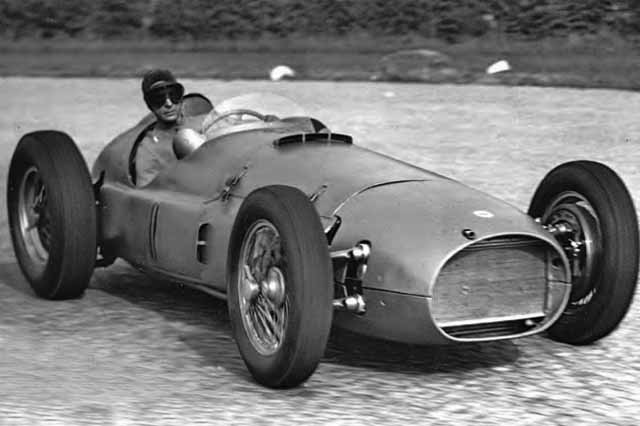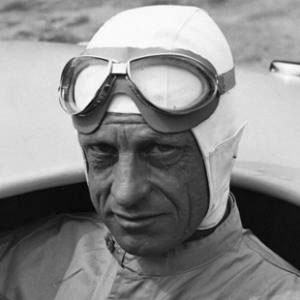William Kenneth “Ken” Richardson (21 August 1911 in Bourne, Lincolnshire – 27 June 1997 in Bourne, Lincolnshire) was a British racing and test / development driver from England who competed in one Formula One World Championship race. Info from Wiki
![]()
Ken Richardson was a British racing and test / development driver from England who competed in one Formula One World Championship race.
Richardson started as an engineer for British Racing Motors, before becoming the main development driver for the BRM V16 project in the early 1950s. He was entered by the team to drive a BRM 15, equipped with the V16 engine, in the 1951 Italian Grand Prix. He qualified the car 10th, but was not allowed to start the race when it emerged that he did not possess the correct racing licence due to his lack of experience. He did not make another attempt at entering a World Championship Formula One race.
In 1949 Guy Anthony Vandervell ordered a Ferrari Tipo 125 Grand Prix car to be used in preparation for the upcoming BRM. The initially delivered Tipo 125 had a 1.5 liter supercharged V-12 and was raced by Raymond Mays and Ken Richardson in the International Trophy race that year. The car carried the “Thinwall Special”, named for Vandervell’s bearing company. The car proved a handful and was crashed by Richardson. Vandervell returned the car to Ferrari and took delivery of a second Tipo 125.
He also drove in the British Grand Prix that year. Sharing the Ferrari with Mays they retired on lap 81 of 100.
In 1950 he went as the reserve driver to the Spanish Grand Prix but his services were not required. Peter Walker retired on lap 5 with a gearbox oil leak and Reg Parnell started slowly, passed 17 cars on the first lap and retired on the second when the supercharger drive shaft snapped.
In 1951 he was asked to stand in for Walker in the Italian Grand Prix. He qualified the BRM P15 V16 in tenth place but was not allowed to start when it emerged that he did not possess the correct racing licence. Hans Stuck was called in as a late replacement. However due to a multitude of problems the cars did not get any sustained high speed running until the morning of the race when it was discovered that the gearboxes were overheating and were at risk of seizing. The decision was taken to withdraw the cars to protect the drivers.
The F1 rules were changes at the end of 1951 and that was it for the v16 BRM, just as it was getting competetive. Richardson was then hired in 1952 by Sir John Black – who was in charge of the Standard Triumph company in the post war period – to develop the “Triumph Sports 20 TS” prototype make a true sports car; so the TR2 was born.
Richardson developed it from what he initially described as ‘the most awful car I’ve ever driven in my life; it’s a deathtrap’, into a very usable sports car.
In May 1953 he drove one, fitted with a standard engine, to an average speed of 124,889 miles or 200,94 km per hour on the Jabbeke motorway. At that time an amazing speed for a volume production car with a 2000 cc capacity. The TR2 was not only as fast as his rival, the Austin Healey, but also cheaper to buy and more economical in use, an average 32 mpg petrol consumption or 6,9 liter per 100 km with a 2 liter engine is even today a model of economy.
The bellicose Black was ousted in a boardroom fracas, also in 1954. The TR line, by contrast, proved pretty venerable. The TR2 became the TR3 in 1956 after 8,628 had been sold, many in the US, and its hearty, homespun spirit survived until the last TR6 was built, 20 years later.
In May 1954 Maurice Gatsonides and Ken Richardson jointly piloted a TR2 to 27th overall in the Mille Miglia. A Competition Department was hastily established, with the first appearance of the works team to be the Alpine Rally barely eight weeks away. Although the company had no experience of either rally preparation of international events, the management hired Maurice Gatsonides (Monte Carlo Rally winner) and Ken Richardson, already on the staff, to head the project.
The first works events in 1954 were the Alpine Rally, and the Tourist Trophy race at Dundrod in Northern Ireland. The TR2’s reliability and competitive edge were apparent in those events. In their first Alpine rally, three TR2s won the team prize and just about every other class award open to them. In the Tourist Trophy race at Dundrod, six TR2s started (one works car and works support for the five others). All six finished, and the two teams of three won the first and second team prizes.
In 1955 he drove at Le Mans in a Triumph TR2 with Bert Hadley, finishing 15th overall.
Probably the most impressive outing for the early TRs was in the 1956 Alpine Rally. As Autocar described the event later that year, “Six cars were entered. They took five ‘Coupes des Alps,’ finished in the first five places in their class, and won the manufacturer’s team prize. The cars had swept the board of almost every prize open to them.” Unfortunately, the Richardson/Heathcote car had to retire when a rear wheel came off or the TR team might have tallied six Coupes des Alps.
The TR3S models were the first to use the famous Sabrina twin-cam engines at LeMans in 1959. The cars were dismantled after the race, and the chassis frames were modified to fit the TRS models raced in 1960 and in 1961, when they won the team prize for Ken.
In January 1962 Richardson was hired by TVR. Disillusioned by the Leyland takeover, Richardson’s first brief was to send three cars to the Sebring 12-hour race in March. The cars were lightweight Mk11As with MkIII style bonnets and 1588cc MGA engines. Axle failure and engine failure eliminated two of them and the surviving car, co-driven by future American star Mark Donohue, could only manage 25th overall and eighth in class. Their extravagant racing programme whch included Le Mans and the Tulip Rally did not yeild results or increased sales and TVR Cars Ltd went bankrupt in October of that year.
He carried on driving until the late 1960’s.






